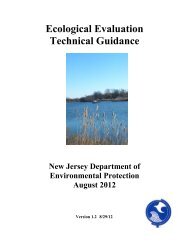Technical and Regulatory Guidance for In Situ Chemical ... - ITRC
Technical and Regulatory Guidance for In Situ Chemical ... - ITRC
Technical and Regulatory Guidance for In Situ Chemical ... - ITRC
You also want an ePaper? Increase the reach of your titles
YUMPU automatically turns print PDFs into web optimized ePapers that Google loves.
Cont amination by PCE <strong>and</strong> TCE was found throughout the thickness of the alluvial aquifer<br />
downgradient of the site at concentrations exceeding MCLs.<br />
Impacted Receptors<br />
Although the City of Wichita does not use water from the affected aquifer <strong>for</strong> municipal water<br />
sup p ly , a few domestic wells were identified within one mile of the site. <strong>In</strong> addition, several<br />
irrigation wells tapping the affected aquifer are present in Linwood Park <strong>and</strong> surrounding areas,<br />
posing inhalation <strong>and</strong> contact risks to the public.<br />
Remedial Objectives<br />
The objective of remedial actions at this site is to reduce groundwater concentrations of PCE <strong>and</strong><br />
TCE to levels at or below their MCLs. Further, PCE <strong>and</strong> TCE present in the vadose zone must be<br />
removed to prevent recontamination of the aquifer.<br />
Selection of Technology <strong>and</strong> Design Parameters<br />
This site was selected <strong>for</strong> implementation of innovative remedial technology, in the <strong>for</strong>m of in situ<br />
chemical oxidation, because the contamination plume was relatively small <strong>and</strong> well defined, <strong>and</strong> the<br />
subsurface geology was simple, well characterized, <strong>and</strong> suitable <strong>for</strong> the p rocess. <strong>In</strong>jection of a liquid<br />
solution of sodium permanganate (NaMnO<br />
4) was selected as the remedial technology, based on its<br />
relatively low cost (compared to traditional pump-<strong>and</strong>-treat systems), ease of implementation, <strong>and</strong><br />
demonstrated ability to oxidize PCE <strong>and</strong> TCE in groundwater. However, this technology was not<br />
deemed effective at oxidizing these contaminants in the unsaturated zone, due to low permeability<br />
<strong>and</strong> inability to evenly distribute the oxidant. There<strong>for</strong>e, to remove PCE <strong>and</strong> TCE in the vadose zone,<br />
a system of SVE wells was employed.<br />
To remediate contaminated groundwater, the sodium permanganate was injected through an array<br />
of hydraulic push probes at the source area. A 4% solution (25 mg/L permanganate) was used based<br />
on a laboratory treatability study; however, this study did not take into account the chemical oxygen<br />
dem<strong>and</strong> of the aquifer sediments.<br />
T o deal with vadose-zone contamination, an array of four SVE wells was installed around the<br />
foundations of the buildings at the site, <strong>and</strong> piping was run from these wells to a master exhaust<br />
blower. These wells were screened in the shallow clayey soils from approximately 8 to 13 feet below<br />
ground surface (bgs), which places them just above the static groundwater level. Emissions<br />
p ermit t ing from the SVE system were not required as the mass of contaminants removed was<br />
anticipated to be less than 50 pounds per day.<br />
Implementation of Technology<br />
Prior to implementing the in situ chemical oxidation process, an array of 11 additional monitoring<br />
wells was installed around <strong>and</strong> downgradient of the source areas to be treated. Wells were installed<br />
in pairs, with one screened in the shallow portion of the aquifer <strong>and</strong> one in the deep portion of the<br />
aquifer. These wells, along with existing monitoring wells adjacent to the site, were sampled prior<br />
to <strong>and</strong> at intervals after treatment to evaluate the effectiveness of the remedy. Samples were tested<br />
<strong>for</strong> PCE <strong>and</strong> TCE concentration, oxidation-reduction potential, pH, dissolved oxygen concentration,<br />
conductivity, <strong>and</strong> temperature, <strong>and</strong> were examined <strong>for</strong> any free-phase oxidant solution present.<br />
T he sodium permanganate solution was injected into an array of 33 hydraulic push probes on<br />
November 1 to November 5, 1999. <strong>In</strong>jection depths were staggered throughout the source areas to<br />
ensure even dispersion throughout the affected aquifer. A total of 757 gallons of 4% solution were<br />
used, <strong>for</strong> an average of 23 gallons per well. However, due to local variations in hydraulic<br />
B7
















